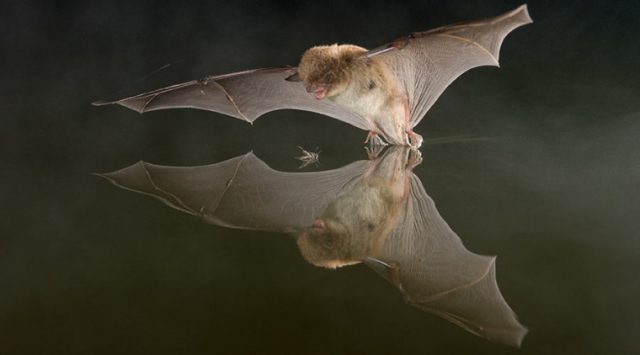Flying tandems

© Paul van Hoof. Bat Conservation Ireland.
Swarm robotics studies the coordination of many simple physical robots that act as a single multirobot system. The interactions between the individual robots and the interaction of the robots with the environment generate a collective behavior that is named swarm behavior. This new discipline moves from the artificial intelligence to the biological world and vice versa. Of course, the most basic swarm is that with just two individuals.
Most biological studies on swarm behavior have been centered on insects (ants, locusts or bees), shoaling fish, and flocking birds but there is another group of flying animals that is also interesting: bats. With very scarce light, swarms of bats take to the air in their nightly food search. They perceive their surroundings by emitting loud and high-pitched biosonar calls and listening for the returning echoes. Animal coordinated movement interactions are commonly explained by assuming unspecified social forces of attraction, repulsion, and alignment, but it seems too simple for bats. They have to maneuver at high speed with complex trajectories without crashing into each other and it was not clear how they did it.
A recent study 1 has focused on echolocating Daubenton’s bats (Myotis daubentonii), an insectivore that weighs a few grams and ranges from Britain to Japan (Hokkaido). The bats emerge at twilight to hunt for insects over lakes and other bodies of water and they forage in pairs. Their main diets consist of small flies, midges, mayflies, and moths. Daubenton’s bat often eats its prey while still in flight, often plucking the bugs off the water’s surface with their feet, like an eagle catching a fish. A seven-gram Daubenton’s bat often returns weighing 11 grams after a one-hour feeding, increasing its body weight by 57% demonstrating its hunting expertise. This species was selected for the flight coordination study because of their tandem flights, their rich behavioral patterns, and their foraging over still water surfaces that reduces the spatiotemporal complexity of the interactions to just a two-dimensional plane.
Daubenton’s bat uses echolocation not just for locating insects but for keeping track of other bats flying in its airspace. Bats lock on to a peer’s sonar calls, follow the flight path of the leader bat and copy its movements to within a few wingbeats. The foraging pairs of bats swapped leader-follower roles and performed chases of coordinated maneuvers by imitating the heading a nearby individual has had up to 500 ms earlier. They follow a few simple “traffic rules” to avoid midair collisions: they chase each other, perform tandem turns and even slow down to avoid a collision.
Once a bat chooses a leader, it will then start mimicking the leader bat’s turns and dives. Since the reaction time is those 500 ms previously mentioned, the two bats’ flights appear almost perfectly synchronized.
For the observer, all these movements look chaotic but the authors proposed what they call the biosonar movement interaction hypothesis, whereby bats interact with each other to perform coordinated movements, based on the information collected by their biosonars. The bats emit their sonar search calls several times per second, record their echoes after hitting any object and interpret them for target detection, recognition, and localization. The directional spatial profiles of the biosonar fields of each bat determine the animals’ mutual positions and headings during flight coordination.
The authors collected nearly 70,000 individual data points during 70 interactions using a 20 ms temporal resolution. For a given point in time, the research group compared the heading of one of the bats with the heading of the other at all other times, thus establishing whether one bat was copying the direction of the other (coordinated flight). Similarly, they compared the position of one of the bats at one time with the position of the other bat at all other times, thus specifying if one bat was copying the position of the other (chase flight).
The system is very fast (reaction time is about 500 ms), in all directions (echolocation provides information from 360 degrees around), the task effort is fairly distributed (some bat pairs trade the role of leader multiple times in a single flight) and flexible (the “lead” bat was not always the one flying in front).
The research team has identified “how” the system works, how bats can zig and zag without crashing but they admit they do not know “why”, the reason the bats follow this system. Different possibilities have been proposed 2 One possibility is that the second bat obtains some benefit such as getting the insects missed by the leader, maybe disoriented by the first attack. A second option is that it can exploit a patch of resources found by the first bat (shared exploitation). A third possibility is that tandem flights provide some advantage such as combining both echoes that would provide a better triangulation. A fourth option is that combining both signals they can cover more territory. A fifth possibility is that some coordinated flights are training exercises between mothers and their offspring
The real answer: we do not know yet.
References
- Giuggioli L, McKetterick TJ, Holderied M (2015) Delayed response and biosonar perception explain movement coordination in trawling bats. PLoS Comput Biol 11(3): e1004089. DOI: 10.1371/journal.pcbi.1004089 ↩
- Bittel J (2015) How Do Swarming Bats Avoid Crashing Into Each Other? National Geographic. March 26. ↩
1 comment
[…] La robótica de enjambres es una disciplina que cada vez está tomando más entidad. Trata de cómo conseguir coordinar varios robots de tal manera que funcionen como una sola entidad robótica. Para conseguirlo se fija mucho en la naturaleza […]